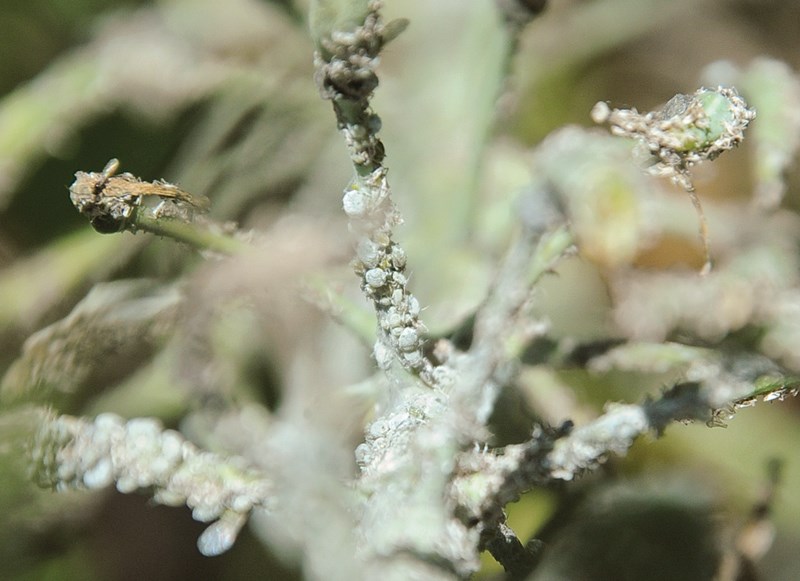Yesterday I spent way too long on my hands and knees digging the sides of more than 200 feet of floating row cover into the ground to keep those nasty flea beetles off my salad greens.
Flea beetles are a common pest on the West Coast, and you’ll find them munching many small holes in leaves of most of your crops. This year I noticed them first on the potatoes, then the kale and chard, then the radishes, and finally they’re heading for my tender salad greens now. Floating row cover is by far the simplest and organic method of controlling flea beetle. It is a light, airy fabric that allows sun and rain to penetrate, but not the bugs (as long as the sides are dug into the ground). If you have a big flea beetle population, they can defoliate young seedlings entirely, so protecting seedlings and germinating seeds with floating row cover is most important. Larger plants can generally withstand munching flea beetles.
To the untrained eye, those cute little white butterflies flitting about the garden are picturesque. What you may not know are the horrors those little white butterflies can and will inflict on your garden. I literally cringed this morning when I looked out to see them dancing about the brassica patch (kale, broccoli, etc.). Soon they will be laying eggs on the underside of kale and broccoli leaves, which emerge into green caterpillars that will feed heavily on any brassica. I left getting floating row cover on too late to protect them entirely; however, I will still put the floating row cover over to help reduce more eggs from being laid. Once the caterpillars emerge I’ll be out there hand picking them as tasty treats for the chickens. I’ve heard that a number of different types of wasps seek out and devour the cabbage moth eggs, so I’ll have my eyes peeled to see them in action – keep your fingers crossed.
I also saw my first batch of aphids in the kale patch this week, which is later than usual. I’ve noticed that there are a lot of lady bugs flying around, and I’m hoping that this late emergence of aphids is due to good predation from the ladybug larvae. In the past I have also had good luck planting nasturtium as a “trap” for aphids. Planted near kale and other crops I know aphids will be attracted to, the aphids will prefer to make a home on the nasturtiums. Once the population is significant, I just pull up the whole nasturtium plant and destroy it, either by soaking it in water or burning it. This takes a big bite out of the aphid population, and makes them easier to control on other crops.
I think that controlling pests organically in the garden is really about having a diverse eco-system of insects. I try to see the pest issues in my garden as imbalances – indicators that more habitat or diversity is needed to re-balance the system. Although I want to stomp on them all when I see a whole row of vegetables demolished, I try to remember that I can do more to support the ecosystem in and around my garden to prevent the major imbalances that create pest infestations. Most insects have a natural predator, so if we can develop habitat that encourages healthy populations in balance with one another, our garden will be shielded from overabundant pests, have a plethora of pollinators, and provide critical habitat for our insect friends.
This year yarrow is bordering almost our entire field – it’s an excellent beneficial insect attractant – and we have plenty of bronze fennel, dill, and other wildflowers growing within our garden. A diversity of flowering plants throughout your garden will encourage beneficial insects like the ladybug to take up residence and help balance the “pest” insects.
A friend and native bee enthusiast was walking through my garden the other day and noticed a black and white hornet hovering and hunting along the rows of flowering mizuna and arugula. They shared that it was an apex predator in the insect world, and a good indicator that we had a complete eco-system.
I know that there will always be some pest damage in my garden, and I will continue to work towards understanding how organic practices can encourage a balance between beneficial insects and what I consider “pest” insects.
Happy gardening!
Emily Jubenvill grew up on the North Shore and is passionate about growing fresh organic food. She’s starting an organic farm, and working for the North Shore Neighbourhood House’s Edible Garden Project. [email protected] ediblegardenproject.com



